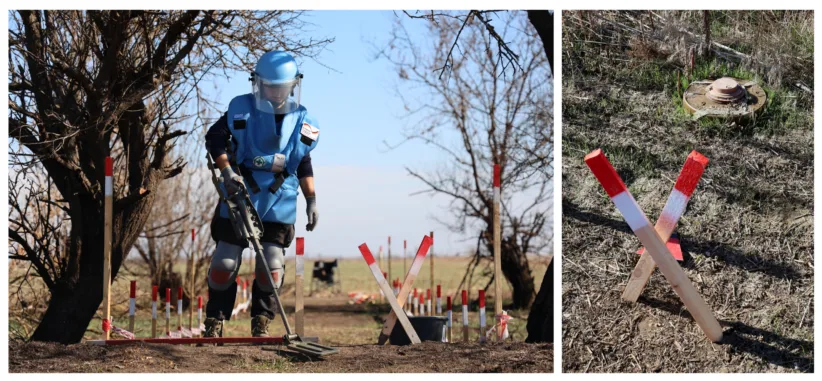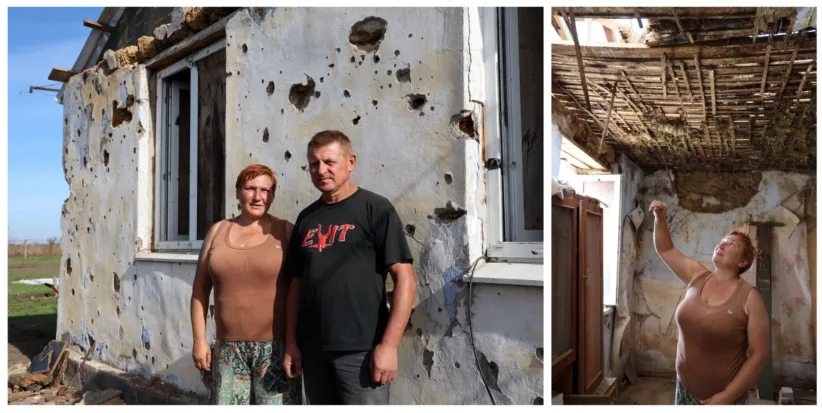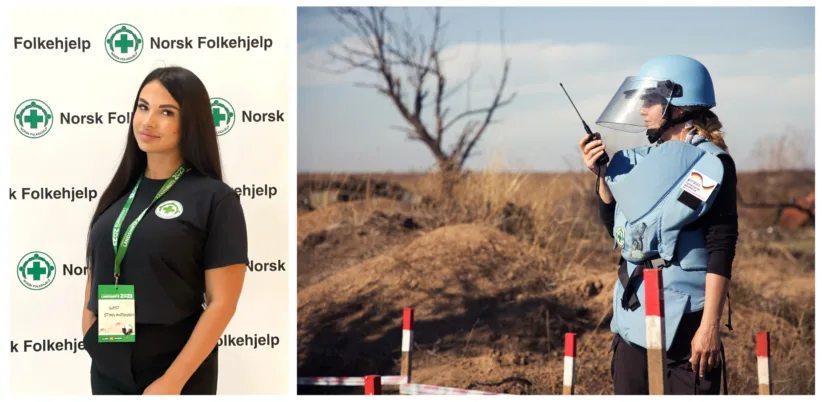Responding to the Largest Humanitarian Crisis in Europe Since World War II
Launching Norwegian People’s Aid's (NPA's) Mine Action Programme in Ukraine

By Marijn van Broekhoven
The full-scale Russian invasion of Ukraine in February 2022 quickly evolved into Europe's largest humanitarian crisis since World War II. According to UNHCR, approximately one-third of Ukraine's population experienced forced displacement, with more than 7 million individuals internally displaced, and over 6 million registered as refugees in other countries. The war became characterized by the widespread use of explosive weapons in populated areas. OCHA indicates that 17.6 million people in Ukraine require humanitarian assistance, with 10.7 million specifically in need of mine action services. Responding to these needs, NPA initiated a mine action programme in May 2022. The launch was led by Alberto Serra, NPA’s Programme Manager for mine action in Ukraine. He explained that the previous conflict that started in 2014 already led to contamination in the eastern part of Ukraine, however, the February 2022 invasion caused further, massive explosive ordnance contamination. The war in Ukraine is unique in the sense that it engages two conventional armies, which affects the type and scale of contamination, making it much larger than other recent conflicts.
NPA initially deployed to the country with a team of only two. Alberto noted that overcoming the bureaucratic hurdles was time-consuming but relatively straightforward and the relevant authorities were seemingly supportive of NPA and its plans for opening a mine action programme in their country. By the end of that summer, NPA had obtained all necessary paperwork to start the planning of activities. Considering Ukraine’s urgent needs but not yet having an operational structure in place, NPA initially supported the State Emergency Services of Ukraine (SESU) by fully equipping 10 new SESU demining teams by the end of 2022. This strategy not only addressed immediate needs, but also affirmed NPA's credibility as an organisation that gets things done, establishing a foundation for future collaboration with SESU. Subsequent activities included the delivery of explosive ordnance risk education (EORE) and conflict preparedness and protection (CPP) sessions through national partners.
The programme started directly implementing mine action activities from February 2023 following successful accreditation for conducting non-technical survey (NTS) and EORE. With this accreditation, NPA immediately deployed teams to the Sumy region in eastern Ukraine to start EORE and NTS activities there, and to Mykolaiv in southern Ukraine the following month. Subsequently, NPA received accreditation to conduct technical survey and manual clearance in early June 2023, with demining teams deploying to the field immediately thereafter. By October 2023, the programme had deployed 12 NTS/EORE teams in Sumy, Mykolaiv, and Kherson regions, and 16 manual demining teams in Mykolaiv region. The programme also continued working with SESU, most notably to develop their mine-detection dog capacity. NPA delivered a total of 14 mine-detection dogs to Ukraine, with six designated for SESU and eight allocated for NPA operations. SESU began deploying the dogs in October, while in November 2023, NPA became the first international organisation in Ukraine accredited for using mine-detection dogs in demining operations.
NPA’s main operational base was opened in Mykolaiv, where all clearance teams are currently operating. Mykolaiv is one of the five Ukrainian regions most affected by explosive ordnance contamination. Illustrating the needs are the experiences from residents like Oleksandr and Liudmila Voskoboinik, whose house sustained heavy damage during the recent fighting, with several walls, windows, and most of the roof destroyed. They also found an unexploded projectile in their shed, which was later removed by SESU. The couple is now staying temporarily with their neighbours as their house is not fit for living. When asked about the explosive ordnance threat, Oleksandr expressed:
“I know that mines were found close to our houses. It’s scary but there is nothing we can do; we have to live here”

Toomas Tamosjunas, the Operations Manager for NPA’s mine action programme in Ukraine, referenced initial challenges in recruiting new teams in Mykolaiv due to limited awareness of NPA. However, as community acceptance grew over time, hiring new staff became easier. The current Ukrainian staff demonstrate high motivation, driven by a strong sense of supporting their communities. Toomas confirmed the dedication of the staff, stating: “The vast majority of our staff take great pride in their work, they feel they are really supporting Ukraine.”
As mine action is still a new concept for most people in Mykolaiv, a lot of the staff are inexperienced, and it will take some time to develop their capacity. However, with part of the country already affected by conflict since 2014, several other Ukrainians with years of mine action experience are confidently stepping into leadership roles. Take Tatiana Velshyna, originally from Lysychansk village in the Luhansk region, which was part of the former confrontation line. She has been working in mine action since 2015. Joining NPA in September 2022 as an EORE/CPP Coordinator, Tatiana's extensive expertise led to her promotion to NTS/EORE Technical Field Manager in May 2023, making her the first national staff member within NPA globally to hold such a position.
Coming from an area that has been fought over since 2014, Tatiana has firsthand experience of the destructive nature of explosive weapons. She recalled the harrowing days when explosions intensified on 24 February 2022: “For the first ten days of the war, I was just in my basement because of the constant artillery shelling, it was so intense, I never counted more than 15 minutes between each explosion.” During a brief respite, Tatiana escaped the village, discovering the destruction of her house later through photos on Facebook. Describing the scene, she remarked: "There was no house left, only bricks…"
Tatiana’s promotion helped the programme to achieve greater diversity in operational management. Despite initial challenges, she highlighted changing attitudes due to the war, with more Ukrainian women taking on traditionally male-dominated roles. The programme also appointed several women as Team Leaders for manual demining teams, including Olha Moskovchenko, who, like Tatiana, brought years of mine action experience to NPA. Olha smiled when she said that she doesn’t really have a problem with supervising men due to her “strong character”.

Although NPA’s direct implementation of mine action activities only started recently, significant results have already been achieved. Since February 2023, NTS/EORE teams identified, mapped, and reported hazardous areas spanning over 8.5 million m2. Additionally, EORE has been provided to more than 9,500 individuals. Starting from June 2023, manual demining teams processed over 6,000 m2 of land through technical survey and clearance. During this process, they found 163 anti-vehicle mines, one anti-personnel mine, and five items of unexploded ordnance, all of which were safely removed.
According to Operations Manager Toomas, the current clearance outputs should not be considered as representative of the teams’ future results. The results to date were achieved by manual demining teams only without additional assets. However, accreditation for using mine-detection dogs was granted on 7 November 2023, and deployment began in late November. NPA is also in the process of obtaining accreditation for the use of mechanical support assets. Once accredited, the teams will have access to the full mine action toolbox, drastically enhancing their operational efficiency and outputs.
Looking ahead, the programme plans to further expand its operational capacity in the coming months, including opening an operational base in Kherson with additional demining teams and initiating technical survey and clearance operations there. Kherson, occupied for a longer period, faces even more severe contamination than Mykolaiv. The gravity of the situation is evident in data provided by the Kherson administration, reporting 140 civilian victims of explosive ordnance accidents in liberated areas in 2023, including 45 fatalities (as of October 2023).
Considering the scale of the problem in Ukraine, many NPA staff have expressed a desire to be able to do more. Nevertheless, witnessing the growth of the mine action programme is truly remarkable, from a mere two individuals in May 2022 to a robust team of over 200 within 1.5 years, deploying 28 operational teams across three regions of Ukraine. As staff gain more experience, with plans for the deployment of additional teams, and teams gaining access to the full mine action toolbox, the operational outputs will only increase. Indeed, Programme Manager Alberto concluded that the most significant achievements so far should not really be seen in the operational outputs, but in establishing the programme, and NPA proving itself to the Ukrainian population and authorities as a reliable organisation that does quality work in a safe and timely manner. Unfortunately, clearing Ukraine of landmines and other explosives will not be easy. It is more of a marathon than a sprint, but NPA is ready for the task.
